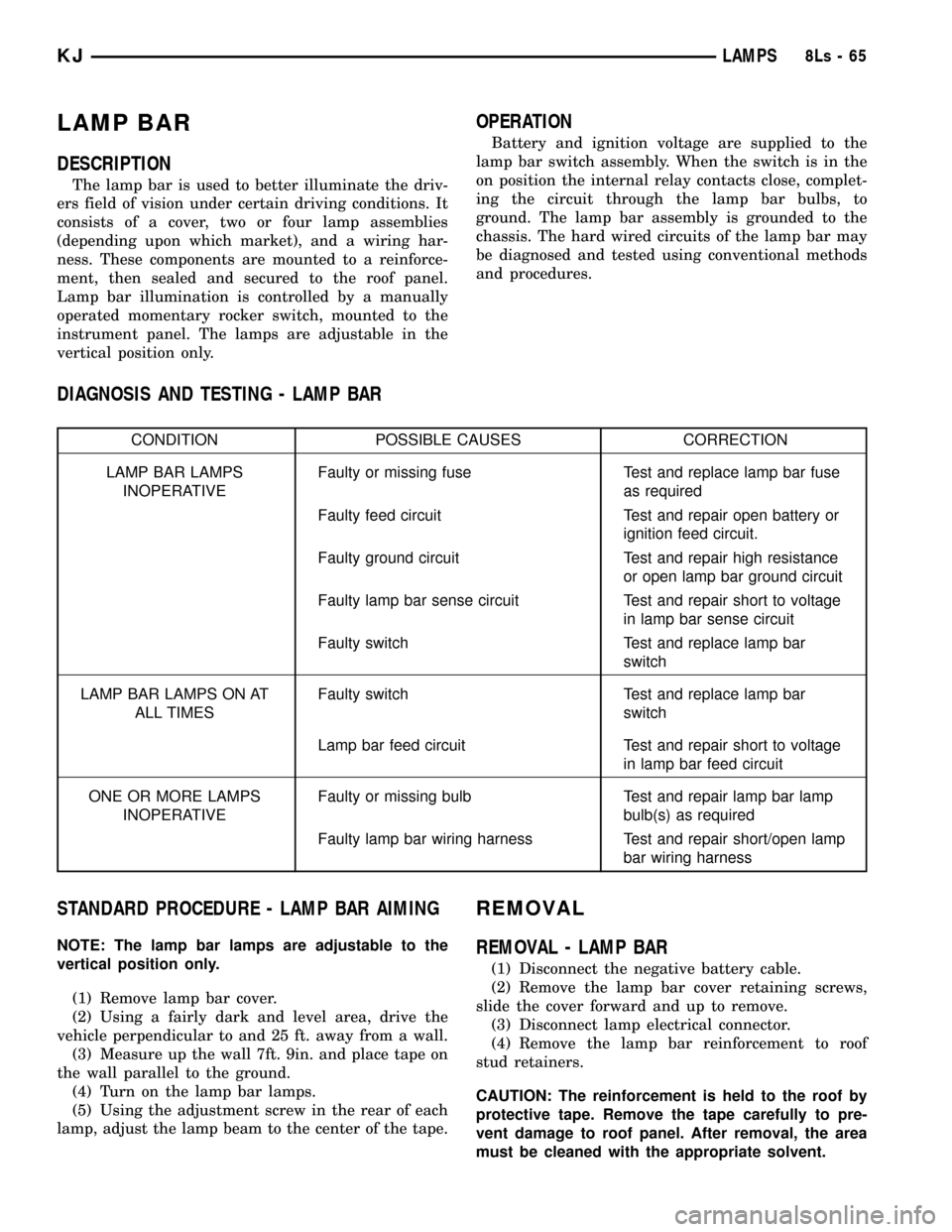fuse panel JEEP LIBERTY 2002 KJ / 1.G Repair Manual
[x] Cancel search | Manufacturer: JEEP, Model Year: 2002, Model line: LIBERTY, Model: JEEP LIBERTY 2002 KJ / 1.GPages: 1803, PDF Size: 62.3 MB
Page 558 of 1803

(5) Position the outer circumference of the boot
seal over the flange on the back of the headlamp unit
housing and pull it downward until the seal is fully
engaged over the flange.
(6) Reinstall the headlamp unit onto the grille
opening reinforcement. (Refer to 8 - ELECTRICAL/
LAMPS/LIGHTING - EXTERIOR/HEADLAMP UNIT
- INSTALLATION).
(7) Reconnect the battery negative cable.
(8) Confirm proper headlamp unit alignment.
(Refer to 8 - ELECTRICAL/LAMPS/LIGHTING -
EXTERIOR/HEADLAMP UNIT - ADJUSTMENTS).
HEADLAMP HIGH BEAM
RELAY
DESCRIPTION
The headlamp high beam relay is located in the
Junction Block (JB) on the driver side outboard end
of the instrument panel in the passenger compart-
ment of the vehicle. The headlamp high beam relay
is omitted from vehicles manufactured for sale in
Canada, which have a Daytime Running Lamp (DRL)
solid state relay installed in the JB that also per-
forms the function of the headlamp high beam relay.
The headlamp high beam relay is a conventional
International Standards Organization (ISO) micro
relay (Fig. 28). Relays conforming to the ISO specifi-
cations have common physical dimensions, current
capacities, terminal patterns, and terminal functions.
The relay is contained within a small, rectangular,molded plastic housing and is connected to all of the
required inputs and outputs by five integral male
spade-type terminals that extend from the bottom of
the relay base.
The headlamp high beam relay cannot be adjusted
or repaired and, if faulty or damaged, the unit must
be replaced.
OPERATION
The headlamp high beam relay is an electrome-
chanical switch that uses a low current input from
the Body Control Module (BCM) to control a high
current output to the headlamp high beam filaments.
The movable common feed contact point is held
against the fixed normally closed contact point by
spring pressure. When the relay coil is energized, an
electromagnetic field is produced by the coil wind-
ings. This electromagnetic field draws the movable
relay contact point away from the fixed normally
closed contact point, and holds it against the fixed
normally open contact point. When the relay coil is
de-energized, spring pressure returns the movable
contact point back against the fixed normally closed
contact point. A resistor is connected in parallel with
the relay coil in the relay, and helps to dissipate volt-
age spikes and electromagnetic interference that can
be generated as the electromagnetic field of the relay
coil collapses.
The headlamp high beam relay terminals are con-
nected to the vehicle electrical system through a con-
nector receptacle in the Junction Block (JB). The
inputs and outputs of the headlamp high beam relay
include:
²Common Feed Terminal- The common feed
terminal (30) receives battery current at all times
from a fuse in the Power Distribution Center (PDC)
through a fused B(+) circuit.
²Coil Ground Terminal- The coil ground termi-
nal (85) is connected to a control output of the Body
Control Module (BCM) through a head lamp relay
control circuit. The BCM controls head lamp opera-
tion by controlling a ground path through this circuit
²Coil Battery Terminal- The coil battery ter-
minal (86) is connected to a control output of the
Body Control Module (BCM) and to the momentary
optical horn (flash-to-pass) output of the multi-func-
tion switch through a high beam relay control circuit.
The BCM and/or the multi-function switch controls
headlamp high beam operation by controlling a
ground path through this circuit.
²Normally Open Terminal- The normally open
terminal (87) is connected to the headlamp high
beam filaments through the high beam relay output
circuit and provides battery current to the headlamp
high beams whenever the relay is energized.
Fig. 28 ISO Micro Relay
30 - COMMON FEED
85 - COIL GROUND
86 - COIL BATTERY
87 - NORMALLY OPEN
87A - NORMALLY CLOSED
KJLAMPS8Ls-33
HEADLAMP BULB (Continued)
Page 562 of 1803

the center of the headlamp reflector and thoroughly
clean any fingerprints from the reflector.
(6) Push the mounting flange of the headlamp lev-
eling motor into the mounting hole on the back of
headlamp unit housing unit the motor is firmly
seated (Fig. 32).
(7) Rotate the headlamp leveling motor on the
back of the headlamp unit housing clockwise about
30 degrees.
(8) Reinstall the headlamp bulb into the headlamp
unit housing. (Refer to 8 - ELECTRICAL/LAMPS/
LIGHTING - EXTERIOR/HEADLAMP BULB -
INSTALLATION).
(9) Reconnect the battery negative cable.
HEADLAMP LEVELING
SWITCH
DESCRIPTION
The headlamp leveling switch (Fig. 34) is used only
on vehicles manufactured for certain markets where
the headlamp leveling system is required. The head-
lamp leveling switch is mounted in the driver side
inboard trim bezel on the instrument panel, where it
is secured by molded latch features that are integral
to the switch housing. Only the switch bezel and
thumbwheel are visible on the outer surface of the
instrument panel trim bezel. The black plastic switch
thumbwheel is marked with white numbers ª0,º ª1,º
ª2,º and ª3,º each of which indicates one of the four
switch detent positions. Each higher number repre-sents a lower aiming position of the headlamp beam
relative to the road surface. The black, molded plas-
tic switch housing has an integral connector recepta-
cle on the back, a single latch feature on the top, and
two latch features (one on each side) on the bottom.
The switch is connected to the vehicle electrical sys-
tem through a dedicated take out and connector of
the instrument panel wire harness. Within the
switch housing is the leveling switch circuitry includ-
ing the switch contacts and a series resistor configu-
ration.
The headlamp leveling switch cannot be adjusted
or repaired and, if faulty or damaged, the unit must
be replaced.
OPERATION
The headlamp leveling switch receives battery cur-
rent on a fused park lamp relay output circuit from a
fuse in the Junction Block (JB) whenever the park
lamp relay is energized (park lamps are turned On).
The switch receives a path to ground through a splice
block located in the instrument panel wire harness
with an eyelet terminal connector that is secured by
a nut to a ground stud on the driver side instrument
panel end bracket near the JB. The only output from
the switch is a voltage signal that it provides to the
headlamp leveling motors on a headlamp adjust sig-
nal circuit. Each switch position selects a different
tap on a series resistor within the switch to provide a
different voltage signal to the leveling motors. The
higher the switch position number, the higher the
output voltage level.
The headlamp leveling switch can be tested using
conventional diagnostic tools and methods.
DIAGNOSIS AND TESTING - HEADLAMP
LEVELING SWITCH
WARNING: ON VEHICLES EQUIPPED WITH AIR-
BAGS, DISABLE THE SUPPLEMENTAL RESTRAINT
SYSTEM BEFORE ATTEMPTING ANY STEERING
WHEEL, STEERING COLUMN, DRIVER AIRBAG,
PASSENGER AIRBAG, SEAT BELT TENSIONER,
FRONT IMPACT SENSORS, SIDE CURTAIN AIRBAG,
OR INSTRUMENT PANEL COMPONENT DIAGNOSIS
OR SERVICE. DISCONNECT AND ISOLATE THE
BATTERY NEGATIVE (GROUND) CABLE, THEN
WAIT TWO MINUTES FOR THE SYSTEM CAPACI-
TOR TO DISCHARGE BEFORE PERFORMING FUR-
THER DIAGNOSIS OR SERVICE. THIS IS THE ONLY
SURE WAY TO DISABLE THE SUPPLEMENTAL
RESTRAINT SYSTEM. FAILURE TO TAKE THE
PROPER PRECAUTIONS COULD RESULT IN ACCI-
DENTAL AIRBAG DEPLOYMENT AND POSSIBLE
PERSONAL INJURY.
Fig. 34 Headlamp Leveling Switch
1 - SWITCH
2 - UPPER LATCH FEATURE (1)
3 - CONNECTOR RECEPTACLE
4 - LOWER LATCH FEATURE (2)
5 - THUMBWHEEL
KJLAMPS8Ls-37
HEADLAMP LEVELING MOTOR (Continued)
Page 564 of 1803

WARNING: ON VEHICLES EQUIPPED WITH AIR-
BAGS, DISABLE THE SUPPLEMENTAL RESTRAINT
SYSTEM BEFORE ATTEMPTING ANY STEERING
WHEEL, STEERING COLUMN, DRIVER AIRBAG,
PASSENGER AIRBAG, SEAT BELT TENSIONER,
FRONT IMPACT SENSORS, SIDE CURTAIN AIRBAG,
OR INSTRUMENT PANEL COMPONENT DIAGNOSIS
OR SERVICE. DISCONNECT AND ISOLATE THE
BATTERY NEGATIVE (GROUND) CABLE, THEN
WAIT TWO MINUTES FOR THE SYSTEM CAPACI-
TOR TO DISCHARGE BEFORE PERFORMING FUR-
THER DIAGNOSIS OR SERVICE. THIS IS THE ONLY
SURE WAY TO DISABLE THE SUPPLEMENTAL
RESTRAINT SYSTEM. FAILURE TO TAKE THE
PROPER PRECAUTIONS COULD RESULT IN ACCI-
DENTAL AIRBAG DEPLOYMENT AND POSSIBLE
PERSONAL INJURY.
(1) From the face of the driver side inboard bezel,
align the headlamp leveling switch housing to the
mounting hole in the bezel (Fig. 36).
(2) Push the headlamp leveling switch into the
mounting hole until it is fully seated and the upper
latch and two lower latch features on the switch
housing are engaged on the back of the bezel.
(3) Position the switch and bezel unit to the
instrument panel.
(4) Reconnect the instrument panel wire harness
connector for the headlamp leveling switch to the
switch connector receptacle.
(5) Reinstall the driver side inboard bezel onto the
instrument panel. (Refer to 23 - BODY/INSTRU-
MENT PANEL/INSTRUMENT PANEL DRIVER
SIDE BEZEL - INSTALLATION).
(6) Reconnect the battery negative cable.
HEADLAMP LOW BEAM RELAY
DESCRIPTION
The headlamp low beam relay is located in the
Junction Block (JB) below the driver side outboard
end of the instrument panel in the passenger com-
partment of the vehicle. The headlamp low beam
relay is a conventional International Standards
Organization (ISO) micro relay (Fig. 37). Relays con-
forming to the ISO specifications have common phys-
ical dimensions, current capacities, terminal
patterns, and terminal functions. The relay is con-
tained within a small, rectangular, molded plastic
housing and is connected to all of the required inputs
and outputs by five integral male spade-type termi-
nals that extend from the bottom of the relay base.
The headlamp low beam relay cannot be adjusted
or repaired and, if faulty or damaged, the unit must
be replaced.
OPERATION
The headlamp low beam relay is an electromechan-
ical switch that uses a low current input from the
Body Control Module (BCM) to control a high current
output to the headlamp low beam filaments. The
movable common feed contact point is held against
the fixed normally closed contact point by spring
pressure. When the relay coil is energized, an electro-
magnetic field is produced by the coil windings. This
electromagnetic field draws the movable relay con-
tact point away from the fixed normally closed con-
tact point, and holds it against the fixed normally
open contact point. When the relay coil is de-ener-
gized, spring pressure returns the movable contact
point back against the fixed normally closed contact
point. A resistor is connected in parallel with the
relay coil in the relay, and helps to dissipate voltage
spikes and electromagnetic interference that can be
generated as the electromagnetic field of the relay
coil collapses.
The headlamp low beam relay terminals are con-
nected to the vehicle electrical system through a con-
nector receptacle in the Junction Block (JB). The
inputs and outputs of the headlamp low beam relay
include:
²Common Feed Terminal- The common feed
terminal (30) receives battery current at all times
from a fuse in the Power Distribution Center (PDC)
through a fused B(+) circuit.
²Coil Ground Terminal- The coil ground termi-
nal (85) receives battery current at all times from a
fuse in the PDC through a fused B(+) circuit.
Fig. 37 ISO Micro Relay
30 - COMMON FEED
85 - COIL GROUND
86 - COIL BATTERY
87 - NORMALLY OPEN
87A - NORMALLY CLOSED
KJLAMPS8Ls-39
HEADLAMP LEVELING SWITCH (Continued)
Page 573 of 1803

²Parade Mode- The internal circuitry and hard-
ware of the multi-function switch left (lighting) con-
trol stalk provide detent switching for a parade mode
that maximizes the illumination intensity of all
instrument panel lighting for visibility when driving
in daylight with the exterior lamps turned on.
²Park Lamps- The internal circuitry and hard-
ware of the multi-function switch left (lighting) con-
trol stalk provide detent switching for the park
lamps.
²Rear Fog Lamps- For vehicles so equipped,
the internal circuitry and hardware of the multi-
function switch left (lighting) control stalk provide
detent switching for the optional rear fog lamps.
Rear fog lamps are optional only for vehicles manu-
factured for certain markets, where they are
required.
²Turn Signal Control- The internal circuitry
and hardware of the multi-function switch left (light-
ing) control stalk provide both momentary non-detent
switching and detent switching with automatic can-
cellation for both the left and right turn signal
lamps.
RIGHT CONTROL STALK The right (wiper) con-
trol stalk of the multi-function switch supports the
following functions and features:
²Continuous Front Wipe Modes- The internal
circuitry and hardware of the multi-function switch
right (wiper) control stalk provide two continuous
front wipe switch positions, low speed or high speed.
²Continuous Rear Wipe Mode- The internal
circuitry and hardware of the multi-function switch
right (wiper) control stalk provide one continuous
rear wipe switch position.
²Front Washer Mode- The internal circuitry
and hardware of the multi-function switch right
(wiper) control stalk switch provide front washer sys-
tem operation.
²Front Wipe-After-Wash Mode- The internal
circuitry and hardware of the multi-function switch
right (wiper) control stalk provide a wipe-after-wash
mode.
²Front Wiper Mist Mode- The internal cir-
cuitry and hardware of the multi-function switch
right (wiper) control stalk provide a front wiper sys-
tem mist mode.
²Intermittent Front Wipe Mode- The internal
circuitry and hardware of the multi-function switch
right (wiper) control stalk provide an intermittent
front wipe mode with five delay interval positions.
²Intermittent Rear Wipe Mode- The internal
circuitry and hardware of the multi-function switch
right (wiper) control stalk provide one fixed interval
intermittent rear wipe mode switch position.²Rear Washer Mode- The internal circuitry and
hardware of the multi-function switch right (wiper)
control stalk provide rear washer system operation.
OPERATION
The multi-function switch uses a combination of
resistor multiplexed and conventionally switched out-
puts to control the many functions and features it
provides. The switch receives battery current on a
fused ignition switch output (run-acc) circuit from a
fuse in the Junction Block (JB) whenever the ignition
switch is in the On or Accessory positions. The switch
receives a path to ground at all times through a
splice block located in the instrument panel wire har-
ness with an eyelet terminal connector that is
secured by a nut to a ground stud on the driver side
instrument panel end bracket near the Junction
Block (JB). Following are descriptions of how each of
the two multi-function switch control stalks operate
to control the functions and features they provide.
LEFT CONTROL STALK The left (lighting) control
stalk of the multi-function switch operates as follows:
²Front Fog Lamps- For vehicles so equipped,
the control knob on the end of the multi-function
switch left (lighting) control stalk is pulled outward
to activate the optional front fog lamps. The control
knob is mechanically keyed so that it cannot be
pulled outward unless it is first rotated to turn on
the exterior lighting. The multi-function switch pro-
vides a resistor multiplexed output to the Body Con-
trol Module (BCM) on a fog lamp switch sense
circuit, and the BCM responds by energizing or de-
energizing the front fog lamp relay in the Junction
Block (JB) as required.
²Headlamps-
The control knob on the end of the
multi-function switch left (lighting) control stalk is
rotated forward (counterclockwise) to its second detent
position to activate the headlamps. The multi-function
switch provides a resistor multiplexed output to the
Body Control Module (BCM) on a headlamp switch
sense circuit, and the BCM responds by energizing or
de-energizing the selected low or high beam relay
(Daytime Running Lamp relay in Canadian vehicles)
in the Junction Block (JB) as required.
²Headlamp Beam Selection-The left (lighting)
control stalk of the multi-function switch is pulled
towards the steering wheel past a detent to actuate
the integral beam select switch circuitry. Each time the
control stalk is activated in this manner, the opposite
headlamp beam from what is currently selected will be
energized. The multi-function switch provides a ground
output to the Body Control Module (BCM) on a high
beam switch sense circuit, and the BCM responds by
energizing or de-energizing the selected low or high
beam relay (Daytime Running Lamp relay in Canadian
vehicles) in the Junction Block (JB) as required.
8Ls - 48 LAMPSKJ
MULTI-FUNCTION SWITCH (Continued)
Page 574 of 1803

²Headlamp Optical Horn- The left (lighting)
control stalk of the multi-function switch is pulled
towards the steering wheel to just before a detent, to
momentarily activate the headlamp optical horn fea-
ture. The high beams will remain illuminated until
the control stalk is released. The multi-function
switch provides a ground output on a high beam
relay control circuit to energize the headlamp high
beam relay (Daytime Running Lamp relay in Cana-
dian vehicles) in the Junction Block (JB) as required.
²Interior Lamps Defeat- The control ring on
the multi-function switch left (lighting) control stalk
is rotated to a full rearward (clockwise) detent to
defeat the illumination of all interior courtesy lamps.
The multi-function switch provides a resistor multi-
plexed output to the Body Control Module (BCM) on
a panel lamps dimmer switch mux circuit, and the
BCM responds by de-energizing its internal courtesy
lamp driver circuit.
²Interior Lamps On- The control ring on the
multi-function switch left (lighting) control stalk is
rotated to a full forward (counterclockwise) detent to
illuminate all interior courtesy lamps. The multi-
function switch provides a resistor multiplexed out-
put to the Body Control Module (BCM) on a panel
lamps dimmer switch mux circuit, and the BCM
responds by energizing its internal courtesy lamp
driver circuit.
²Panel Lamps Dimming- The control ring on
the multi-function switch left (lighting) control stalk
is rotated to one of six minor intermediate detents to
simultaneously select the desired illumination inten-
sity of all adjustable instrument panel and instru-
ment cluster lighting. The control ring is rotated
rearward (clockwise) to dim, or forward (counter-
clockwise) to brighten. The multi-function switch pro-
vides a resistor multiplexed output to the Body
Control Module (BCM) on a panel lamps dimmer
switch mux circuit, and the BCM responds by send-
ing an electronic panel lamps dimming level message
to the ElectroMechanical Instrument Cluster (EMIC)
over the Programmable Communications Interface
(PCI) data bus. The EMIC electronic circuitry then
provides the proper PWM output to the cluster illu-
mination lamps and the VFD on the EMIC circuit
board, then provides a matching PWM output on the
hard wired fused panel lamps dimmer switch signal
circuit.
²Parade Mode- The control ring on the multi-
function switch left (lighting) control stalk is rotated
to an intermediate detent that is one detent rear-
ward (clockwise) from the full forward (counterclock-
wise) detent to select the Parade mode. The multi-
function switch provides a resistor multiplexed
output to the Body Control Module (BCM) on a panel
lamps dimmer switch mux circuit, and the BCMresponds by sending an electronic panel lamps dim-
ming level message to the ElectroMechanical Instru-
ment Cluster (EMIC) over the Programmable
Communications Interface (PCI) data bus. The EMIC
electronic circuitry then provides the proper PWM
output to the cluster illumination lamps and the
VFD on the EMIC circuit board, then provides a
matching PWM output on the hard wired fused panel
lamps dimmer switch signal circuit to illuminate all
lamps at full (daylight) intensity with the exterior
lamps turned On.
²Park Lamps- The control knob on the end of
the multi-function switch left (lighting) control stalk
is rotated forward (counterclockwise) to its first
detent from the Off position to activate the park
lamps. The multi-function switch provides a resistor
multiplexed output to the Body Control Module
(BCM) on a headlamp switch sense circuit, and the
BCM responds by energizing or de-energizing the
park lamp relay in the Junction Block (JB) as
required.
²Rear Fog Lamps- For vehicles so equipped,
the control knob on the end of the multi-function
switch left (lighting) control stalk is rotated forward
(counterclockwise) to its third detent position to acti-
vate the rear fog lamps. The multi-function switch
provides a resistor multiplexed output to the Body
Control Module (BCM) on a headlamp switch sense
circuit, and the BCM responds by energizing or de-
energizing the rear fog lamp relay in the Junction
Block (JB) as required. Rear fog lamps are optional
only for vehicles manufactured for certain markets,
where they are required.
²Turn Signal Control- The left (lighting) con-
trol stalk of the multi-function switch is moved
upward to activate the right turn signal circuitry,
and, downward to activate the left turn signal cir-
cuitry. The turn signal switch has a detent position
in each direction that provides turn signals with
automatic cancellation, and an intermediate, momen-
tary position in each direction that provides turn sig-
nals only until the left multi-function switch control
stalk is released. When the control stalk is moved to
a turn signal switch detent position, the cancel
actuator extends toward the center of the steering
column. A turn signal cancel cam that is integral to
the clockspring rotates with the steering wheel and
the cam lobes contact the cancel actuator when it is
extended from the left multi-function switch. When
the steering wheel is rotated during a turning
maneuver, one of the two turn signal cancel cam
lobes will contact the turn signal cancel actuator. The
cancel actuator latches against the cancel cam rota-
tion in the direction opposite that which is signaled.
In other words, if the left turn signal detent is
selected, the lobes of the cancel cam will ratchet past
KJLAMPS8Ls-49
MULTI-FUNCTION SWITCH (Continued)
Page 579 of 1803

(3) Position the multi-function switch onto the
steering column lock housing. Be certain that the
switch alignment posts and locator tabs are fully
seated on the lock housing.
(4) Position the upper and lower shrouds onto the
steering column.
(5) Align the snap features on the lower shroud
with the receptacles on the upper shroud and apply
hand pressure to snap them together.
(6) From below the steering column, install and
tighten the two screws that secure the lower shroud
to the upper shroud. Tighten the screws to 2 N´m (20
in. lbs.).
(7) If the vehicle is equipped with the optional tilt
steering column, move the tilt steering column back
to the fully raised position and move the tilt release
lever into the locked (up) position.
(8) Reconnect the battery negative cable.
PARK LAMP RELAY
DESCRIPTION
The park lamp relay is located in the Junction
Block (JB) below the driver side outboard end of the
instrument panel in the passenger compartment of
the vehicle. The park lamp relay is a conventional
International Standards Organization (ISO) micro
relay (Fig. 53). Relays conforming to the ISO specifi-
cations have common physical dimensions, current
capacities, terminal patterns, and terminal functions.
The relay is contained within a small, rectangular,
molded plastic housing and is connected to all of therequired inputs and outputs by five integral male
spade-type terminals that extend from the bottom of
the relay base.
The park lamp relay cannot be adjusted or
repaired and, if faulty or damaged, the unit must be
replaced.
OPERATION
The park lamp relay is an electromechanical
switch that uses a low current input from the Body
Control Module (BCM) to control a high current out-
put to the park lamps. The movable common feed
contact point is held against the fixed normally
closed contact point by spring pressure. When the
relay coil is energized, an electromagnetic field is
produced by the coil windings. This electromagnetic
field draws the movable relay contact point away
from the fixed normally closed contact point, and
holds it against the fixed normally open contact
point. When the relay coil is de-energized, spring
pressure returns the movable contact point back
against the fixed normally closed contact point. A
resistor is connected in parallel with the relay coil in
the relay, and helps to dissipate voltage spikes and
electromagnetic interference that can be generated as
the electromagnetic field of the relay coil collapses.
The park lamp relay terminals are connected to
the vehicle electrical system through a connector
receptacle in the Junction Block (JB). The inputs and
outputs of the park lamp relay include:
²Common Feed Terminal- The common feed
terminal (30) is connected to the park lamps through
the park lamp relay output circuit and provides
ground to the park lamps when the relay is de-ener-
gized, and battery current to the park lamps when-
ever the relay is energized.
²Coil Ground Terminal-
The coil ground termi-
nal (85) is connected to a control output of the Body
Control Module (BCM) through a park lamp relay con-
trol circuit. The BCM controls park lamp operation by
controlling a ground path through this circuit.
²Coil Battery Terminal- The coil battery ter-
minal (86) receives battery current at all times from
a fuse in the PDC through a fused B(+) circuit.
²Normally Open Terminal- The normally open
terminal (87) receives battery current at all times
from a fuse in the Power Distribution Center (PDC)
through a fused B(+) circuit.
²Normally Closed Terminal- The normally
closed terminal (87A) is connected to ground at all
times through a ground circuit that receives ground
through a splice block located in the instrument
panel wire harness with an eyelet terminal connector
that is secured by a nut to a ground stud on the
driver side instrument panel end bracket near the
Junction Block (JB).
Fig. 53 ISO Micro Relay
30 - COMMON FEED
85 - COIL GROUND
86 - COIL BATTERY
87 - NORMALLY OPEN
87A - NORMALLY CLOSED
8Ls - 54 LAMPSKJ
MULTI-FUNCTION SWITCH (Continued)
Page 582 of 1803

OPERATION
The rear fog lamp relay is an electromechanical
switch that uses a low current input from the Body
Control Module (BCM) to control a high current out-
put to the rear fog lamps. The movable common feed
contact point is held against the fixed normally
closed contact point by spring pressure. When the
relay coil is energized, an electromagnetic field is
produced by the coil windings. This electromagnetic
field draws the movable relay contact point away
from the fixed normally closed contact point, and
holds it against the fixed normally open contact
point. When the relay coil is de-energized, spring
pressure returns the movable contact point back
against the fixed normally closed contact point. A
resistor is connected in parallel with the relay coil in
the relay, and helps to dissipate voltage spikes and
electromagnetic interference that can be generated as
the electromagnetic field of the relay coil collapses.
The rear fog lamp relay terminals are connected to
the vehicle electrical system through a connector
receptacle in the Junction Block (JB). The inputs and
outputs of the rear fog lamp relay include:
²Common Feed Terminal- The common feed
terminal (30) receives battery current at all times
from a fuse in the JB through a fused B(+) circuit.
²Coil Ground Terminal- The coil ground termi-
nal (85) is connected to a control output of the pre-
mium Body Control Module (BCM) through a rear
fog lamp relay control circuit. The BCM controls rear
fog lamp operation by controlling a ground path
through this circuit.
²Coil Battery Terminal- The coil battery ter-
minal (86) receives battery current at all times from
a fuse in the JB through a fused B(+) circuit.
²Normally Open Terminal- The normally open
terminal (87) is connected to the rear fog lamps
through a rear fog lamp relay output circuit and pro-
vides battery current to the rear fog lamps whenever
the relay is energized.
²Normally Closed Terminal- The normally
closed terminal (87A) is not connected in this appli-
cation.
The rear fog lamp relay can be diagnosed using
conventional diagnostic tools and methods.
DIAGNOSIS AND TESTING - REAR FOG LAMP
RELAY
The rear fog lamp relay (Fig. 57) is located in the
Junction Block (JB) under the driver side outboard
end of the instrument panel. Refer to the appropriate
wiring information. The wiring information includes
wiring diagrams, proper wire and connector repair
procedures, details of wire harness routing and
retention, connector pin-out information and locationviews for the various wire harness connectors, splices
and grounds.
WARNING: ON VEHICLES EQUIPPED WITH AIR-
BAGS, DISABLE THE SUPPLEMENTAL RESTRAINT
SYSTEM BEFORE ATTEMPTING ANY STEERING
WHEEL, STEERING COLUMN, DRIVER AIRBAG,
PASSENGER AIRBAG, SEAT BELT TENSIONER,
FRONT IMPACT SENSORS, SIDE CURTAIN AIRBAG,
OR INSTRUMENT PANEL COMPONENT DIAGNOSIS
OR SERVICE. DISCONNECT AND ISOLATE THE
BATTERY NEGATIVE (GROUND) CABLE, THEN
WAIT TWO MINUTES FOR THE SYSTEM CAPACI-
TOR TO DISCHARGE BEFORE PERFORMING FUR-
THER DIAGNOSIS OR SERVICE. THIS IS THE ONLY
SURE WAY TO DISABLE THE SUPPLEMENTAL
RESTRAINT SYSTEM. FAILURE TO TAKE THE
PROPER PRECAUTIONS COULD RESULT IN ACCI-
DENTAL AIRBAG DEPLOYMENT AND POSSIBLE
PERSONAL INJURY.
(1) Remove the rear fog lamp relay from the JB.
(Refer to 8 - ELECTRICAL/LAMPS/LIGHTING -
EXTERIOR/REAR FOG LAMP RELAY - REMOVAL).
(2) A relay in the de-energized position should
have continuity between terminals 87A and 30, and
no continuity between terminals 87 and 30. If OK, go
to Step 3. If not OK, replace the faulty relay.
(3) Resistance between terminals 85 and 86 (elec-
tromagnet) should be 75 8 ohms. If OK, go to Step
4. If not OK, replace the faulty relay.
Fig. 57 ISO Micro Relay
30 - COMMON FEED
85 - COIL GROUND
86 - COIL BATTERY
87 - NORMALLY OPEN
87A - NORMALLY CLOSED
KJLAMPS8Ls-57
REAR FOG LAMP RELAY (Continued)
Page 587 of 1803

TRAILER TOW RELAY
DESCRIPTION
The trailer tow relays are located in a connector
bank above the right rear wheelhouse and behind the
quarter trim panel on vehicles equipped with the
optional factory-installed trailer towing package.
Four individual relays are used, one each for fused
ignition switch output (run), brake lamps, right turn
signal, and left turn signal outputs to a trailer
through the rear body wiring and connectors. The
trailer tow relays are conventional International
Standards Organization (ISO) micro relays (Fig. 64).
Relays conforming to the ISO specifications have
common physical dimensions, current capacities, ter-
minal patterns, and terminal functions. The relay is
contained within a small, rectangular, molded plastic
housing and is connected to all of the required inputs
and outputs by five integral male spade-type termi-
nals that extend from the bottom of the relay base.
The trailer tow relays cannot be adjusted or
repaired and, if faulty or damaged, the inoperative
relay must be replaced.
OPERATION
The trailer tow relays are electromechanical
switches. The relays each use an input from the cir-
cuit that they isolate from the trailer wiring to con-
trol a high current output to the trailer. The movable
common feed contact point is held against the fixed
normally closed contact point by spring pressure.When the relay coil is energized, an electromagnetic
field is produced by the coil windings. This electro-
magnetic field draws the movable relay contact point
away from the fixed normally closed contact point,
and holds it against the fixed normally open contact
point. When the relay coil is de-energized, spring
pressure returns the movable contact point back
against the fixed normally closed contact point. A
resistor is connected in parallel with the relay coil in
the relay, and helps to dissipate voltage spikes and
electromagnetic interference that can be generated as
the electromagnetic field of the relay coil collapses.
The terminals of each trailer tow relay are con-
nected to the vehicle electrical system through a con-
nector bank in the rear lighting wire harness above
the right rear wheelhouse. Refer to the appropriate
wiring information. The wiring information includes
wiring diagrams, proper wire and connector repair
procedures, details of wire harness routing and
retention, connector pin-out information and location
views for the various wire harness connectors, splices
and grounds. The trailer tow relays can be diagnosed
using conventional diagnostic tools and methods.
DIAGNOSIS AND TESTING - TRAILER TOW
RELAY
The trailer tow relays (Fig. 65) are located in a
connector bank above the right rear wheelhouse.
Refer to the appropriate wiring information. The wir-
ing information includes wiring diagrams, proper
wire and connector repair procedures, details of wire
harness routing and retention, connector pin-out
information and location views for the various wire
harness connectors, splices and grounds.
WARNING: ON VEHICLES EQUIPPED WITH AIR-
BAGS, DISABLE THE SUPPLEMENTAL RESTRAINT
SYSTEM BEFORE ATTEMPTING ANY STEERING
WHEEL, STEERING COLUMN, DRIVER AIRBAG,
PASSENGER AIRBAG, SEAT BELT TENSIONER,
FRONT IMPACT SENSORS, SIDE CURTAIN AIRBAG,
OR INSTRUMENT PANEL COMPONENT DIAGNOSIS
OR SERVICE. DISCONNECT AND ISOLATE THE
BATTERY NEGATIVE (GROUND) CABLE, THEN
WAIT TWO MINUTES FOR THE SYSTEM CAPACI-
TOR TO DISCHARGE BEFORE PERFORMING FUR-
THER DIAGNOSIS OR SERVICE. THIS IS THE ONLY
SURE WAY TO DISABLE THE SUPPLEMENTAL
RESTRAINT SYSTEM. FAILURE TO TAKE THE
PROPER PRECAUTIONS COULD RESULT IN ACCI-
DENTAL AIRBAG DEPLOYMENT AND POSSIBLE
PERSONAL INJURY.
Fig. 64 Trailer Tow Relays
1 - RELAY CONNECTOR BANK
2 - REAR BODY WIRE HARNESS
3 - LEFT TURN RELAY
4 - RIGHT TURN RELAY
5 - BRAKE LAMP RELAY
6 - FUSED IGNITION SWITCH OUTPUT (RUN) RELAY
8Ls - 62 LAMPSKJ
Page 589 of 1803

WARNING: ON VEHICLES EQUIPPED WITH AIR-
BAGS, DISABLE THE SUPPLEMENTAL RESTRAINT
SYSTEM BEFORE ATTEMPTING ANY STEERING
WHEEL, STEERING COLUMN, DRIVER AIRBAG,
PASSENGER AIRBAG, SEAT BELT TENSIONER,
FRONT IMPACT SENSORS, SIDE CURTAIN AIRBAG,
OR INSTRUMENT PANEL COMPONENT DIAGNOSIS
OR SERVICE. DISCONNECT AND ISOLATE THE
BATTERY NEGATIVE (GROUND) CABLE, THEN
WAIT TWO MINUTES FOR THE SYSTEM CAPACI-
TOR TO DISCHARGE BEFORE PERFORMING FUR-
THER DIAGNOSIS OR SERVICE. THIS IS THE ONLY
SURE WAY TO DISABLE THE SUPPLEMENTAL
RESTRAINT SYSTEM. FAILURE TO TAKE THE
PROPER PRECAUTIONS COULD RESULT IN ACCI-
DENTAL AIRBAG DEPLOYMENT AND POSSIBLE
PERSONAL INJURY.
(1) Position the trailer tow relay to the proper con-
nector in the connector bank (Fig. 67).
(2) Align the trailer tow relay terminals with the
terminal cavities in the connector.
(3) Push firmly and evenly on the top of the trailer
tow relay until the terminals are fully seated in the
terminal cavities in the connector.
(4) Carefully restore the foam wrap around the
trailer tow relay connector bank (Fig. 66).
(5) Reach through the access hole in the quarter
inner panel behind the right rear wheelhouse to
place the trailer tow relay connector bank on the top
of the right rear wheelhouse between the quarter
inner and outer panels.(6) Reinstall the trim onto the right side quarter
inner panel. (Refer to 23 - BODY/INTERIOR/QUAR-
TER TRIM PANEL - INSTALLATION).
(7) Reconnect the battery negative cable.
TRAILER TOW WIRING
DESCRIPTION
Vehicles equipped with an optional factory-in-
stalled (not dealer-installed or port-installed) trailer
towing package have a rear body wire harness that
includes an integral trailer tow wiring take out that
connects to a heavy duty, sealed, 7-pin trailer tow
connector located on a bracket on the trailer hitch
receiver (Fig. 68). This harness includes a second
take out with a trailer tow relay connector bank and
four trailer tow relays that isolate the right turn sig-
nal, left turn signal, and brake lamp circuits of the
vehicle from the electrical system of the trailer. The
fourth relay in the connector bank provides a fused
ignition switch output (run) source of battery current
to the trailer tow connector through a trailer tow
relay output circuit. The package also includes an
adapter harness (stored beneath the left rear seat
cushion of the vehicle when it is shipped from the
factory) that adapts the 7-pin trailer tow connector to
a standard, light-duty, 4-pin trailer tow connector.
Refer to the appropriate wiring information. The wir-
ing information includes wiring diagrams, proper
wire and connector repair procedures, further details
on wire harness routing and retention, as well as
pin-out and location views for the various wire har-
ness connectors, splices and grounds.
Fig. 67 Trailer Tow Relay Remove/Install
1 - RELAY CONNECTOR BANK
2 - REAR BODY WIRE HARNESS
3 - LEFT TURN RELAY
4 - RIGHT TURN RELAY
5 - BRAKE LAMP RELAY
6 - FUSED IGNITION SWITCH OUTPUT (RUN) RELAY
Fig. 68 Trailer Tow Wiring
1 - RETAINER CLIP (4)
2 - REAR BODY HARNESS (TRAILER TOW TAKE OUT)
3 - RETAINER CLIP (2)
4 - WIRE HARNESS CONNECTOR
8Ls - 64 LAMPSKJ
TRAILER TOW RELAY (Continued)
Page 590 of 1803

LAMP BAR
DESCRIPTION
The lamp bar is used to better illuminate the driv-
ers field of vision under certain driving conditions. It
consists of a cover, two or four lamp assemblies
(depending upon which market), and a wiring har-
ness. These components are mounted to a reinforce-
ment, then sealed and secured to the roof panel.
Lamp bar illumination is controlled by a manually
operated momentary rocker switch, mounted to the
instrument panel. The lamps are adjustable in the
vertical position only.
OPERATION
Battery and ignition voltage are supplied to the
lamp bar switch assembly. When the switch is in the
on position the internal relay contacts close, complet-
ing the circuit through the lamp bar bulbs, to
ground. The lamp bar assembly is grounded to the
chassis. The hard wired circuits of the lamp bar may
be diagnosed and tested using conventional methods
and procedures.
DIAGNOSIS AND TESTING - LAMP BAR
CONDITION POSSIBLE CAUSES CORRECTION
LAMP BAR LAMPS
INOPERATIVEFaulty or missing fuse Test and replace lamp bar fuse
as required
Faulty feed circuit Test and repair open battery or
ignition feed circuit.
Faulty ground circuit Test and repair high resistance
or open lamp bar ground circuit
Faulty lamp bar sense circuit Test and repair short to voltage
in lamp bar sense circuit
Faulty switch Test and replace lamp bar
switch
LAMP BAR LAMPS ON AT
ALL TIMESFaulty switch Test and replace lamp bar
switch
Lamp bar feed circuit Test and repair short to voltage
in lamp bar feed circuit
ONE OR MORE LAMPS
INOPERATIVEFaulty or missing bulb Test and repair lamp bar lamp
bulb(s) as required
Faulty lamp bar wiring harness Test and repair short/open lamp
bar wiring harness
STANDARD PROCEDURE - LAMP BAR AIMING
NOTE: The lamp bar lamps are adjustable to the
vertical position only.
(1) Remove lamp bar cover.
(2) Using a fairly dark and level area, drive the
vehicle perpendicular to and 25 ft. away from a wall.
(3) Measure up the wall 7ft. 9in. and place tape on
the wall parallel to the ground.
(4) Turn on the lamp bar lamps.
(5) Using the adjustment screw in the rear of each
lamp, adjust the lamp beam to the center of the tape.
REMOVAL
REMOVAL - LAMP BAR
(1) Disconnect the negative battery cable.
(2) Remove the lamp bar cover retaining screws,
slide the cover forward and up to remove.
(3) Disconnect lamp electrical connector.
(4) Remove the lamp bar reinforcement to roof
stud retainers.
CAUTION: The reinforcement is held to the roof by
protective tape. Remove the tape carefully to pre-
vent damage to roof panel. After removal, the area
must be cleaned with the appropriate solvent.
KJLAMPS8Ls-65